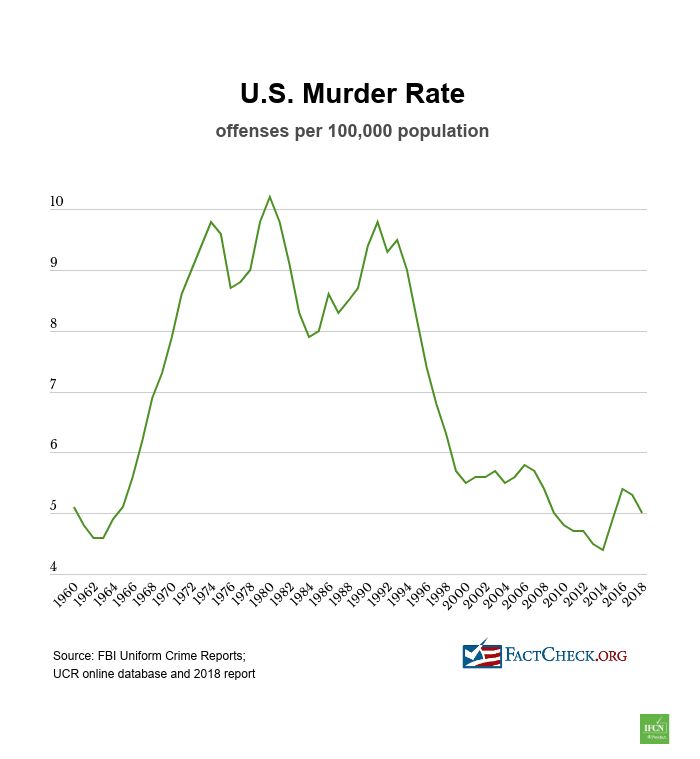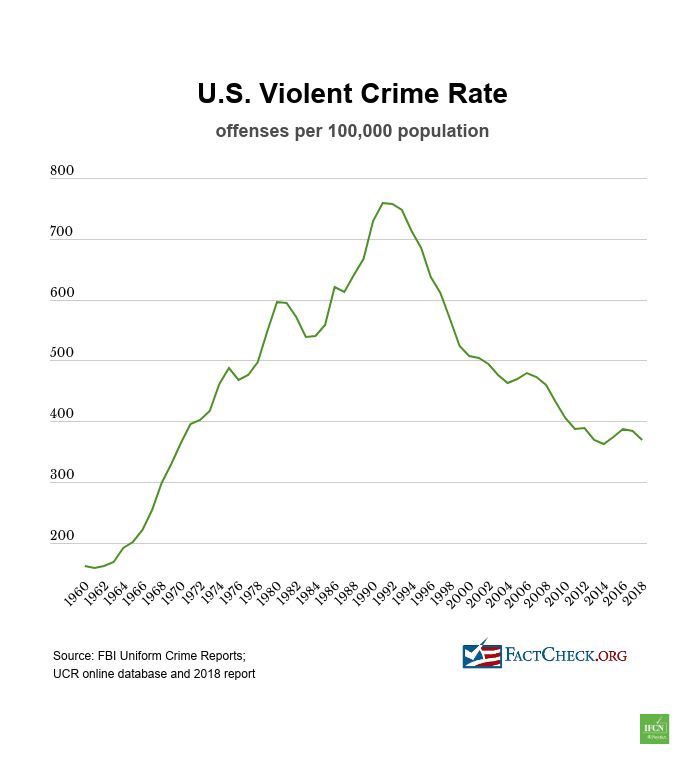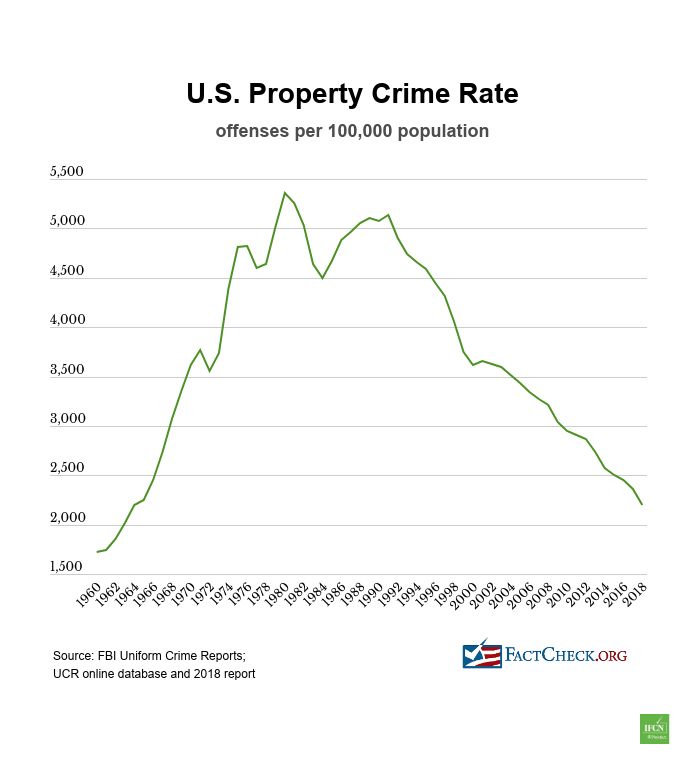President Donald Trump wrongly claimed that “our crime statistics are at a level that they haven’t been at,” calling the numbers “record setting.” The U.S. murder rate was lower in 2014, and the violent crime rate overall has been lower in several past years, with the lowest levels decades ago, according to FBI data.
The president’s claims continue a pattern of distorting the facts on crime.
As a candidate in 2016, Trump repeatedly made the bogus claim that the murder rate in the U.S. was the “highest it’s been in 45 years.” The rate in 2015 actually was lower than any other time between 1965 and 2009. He also hyped a year-over-year increase in some cities, claiming, “violent crime has increased in cities across America.” But crime had been declining over the long term, and experts caution against discerning a pattern from a few years of data.
Now, after more than three years in office, Trump has touted low crime statistics, falsely claiming a “record.”
In a June 8 roundtable meeting with law enforcement officers, Trump said of police, “And they’ve done jobs that are record setting. Record setting. So our crime statistics are at a level that they haven’t been at.” Later in the meeting, he reiterated the point: “As I said, their records are being broken, in terms of lack of crime,” saying that the police had “a tremendous 36 months, I think you can say, during the term.”
The same day, Trump tweeted: “This year has seen the lowest crime numbers in our Country’s recorded history.”
We asked the White House press office for support for the claims, but we haven’t received a response.
“It’s simply incorrect to say these are the lowest rates in our recorded history,” said Richard Rosenfeld, professor emeritus at the University of Missouri–St. Louis’ Department of Criminology and Criminal Justice, who researches U.S. crime trends.
The most recent FBI statistics on the rate and number of crimes are for 2018. They show that crime has declined since Trump became president, but the statistics aren’t “at a level that they haven’t been at.” And historically, these figures have been generally declining for years.
The FBI statistics show “crime generally has been going down [for] quite some time, and well before Trump took office,” Richard Berk, professor of criminology and statistics at the University of Pennsylvania, told us in an email. “If you believe the national data, there has been a pretty long term decline.”
Crime Trends
The FBI’s Uniform Crime Reporting Statistics, which is based on voluntary reporting by local police departments, publishes yearly estimates on both violent and property crimes. The long-term trend shows the estimated violent crime rate — crimes, including murder, rape, robbery and aggravated assault, per 100,000 people — peaked in the early 1990s, at 758.2 in 1991, and the rate has been on a steady drop since.
It was less than half that, 361.6 in 2014. The rate went up a bit in 2015 and 2016 and was 368.9 in 2018, the latest figure available. But the violent crime rate was lower in 2014 and even lower in the 1960s than it has been in recent years.
The FBI’s Uniform Crime Reports go all the way back to 1930. However, the data was reported in different ways: monthly at first, then quarterly and then semiannually through the late 1950s. To show the yearly figures, we used 1960 as our starting point for these graphs. But crime rates were even lower in prior years.
In the “Uniform Crime Reports for the United States” publication for 1960, the FBI notes that the decade started off with much higher levels of crime than 10 or 20 years earlier. “In 1960, the crime rate was 24 percent above the average for the past 5 years; 66 percent over 1950; and 96 percent higher than 1940.” That’s for all crimes, not only violent crime.
“We had crime rates during the 1950s … that are lower than they are right now,” Rosenfeld told us.
As for the murder rate, it has dropped during Trump’s time in office, from 5.4 per 100,000 people in 2016 to 5.0 in 2018. But that’s still higher than the 4.4 record low in 2014, at least dating back to 1960. In fact, the murder rate was lower than 5.0 every year from 2010 to 2015, and also from 1961 to 1964.
The murder rate peaked in 1980 at 10.2 and, like violent crime overall, has generally declined since the early 1990s.

Property crime, too — burglary, larceny and motor vehicle theft — shows a similar trend, with lower crime rates in the 1960s than the U.S. has now. And the rates were lower yet in the late 1950s, according to older Uniform Crime Reports.
More Recent Trends
As the graphs above show, despite the long-term decline since the 1990s, the violent crime and murder rates ticked up in 2015 and 2016, before dropping again. Rosenfeld said the increase in those two years was “clearly associated with the widespread controversy and unrest” connected to the killing of Michael Brown, an unarmed black man, by a white police officer in Ferguson, Missouri, and additional police incidents in other U.S. cities.
Crime rates, Rosenfeld said, “will go up or down for all kinds of reasons.” The 2015-2016 increase is an example of an exogenous shock, an unpredictable change in crime rates because of an external event, he said. A second example is the impact due to stay-at-home and quarantine orders during the coronavirus pandemic.
Rosenfeld is working on a study of 64 of the largest U.S. cities that found the average homicide rate declined in April and May during the coronavirus mitigation efforts, compared with the previous three-year average for those months. “The drop in April was about twice as large as the drop in May,” he said, which would be consistent with the idea that crime would get back to what normally would be expected as those mitigation efforts were lifted.
The Major Cities Chiefs Association has published figures for 2019 based on data from 68 local police departments. Those figures show an increase in the number of homicides and aggravated assaults for 2019, compared with 2018, and a decrease in rape and robbery. The association also has a quarterly comparison of January through March 2020 with the same period in 2019; that shows an increase in homicides, aggravated assaults and robbery. Those are sheer numbers, not adjusted for population, but they don’t suggest support for the president’s claim.
The FBI won’t release national crime rates for 2019 until it publishes its yearly figures, typically in September. It did release a preliminary report for the first six months of 2019 that didn’t include the numbers or rates of crimes, but included information on percentage changes. The report said the number of violent crimes had declined 3.1% compared with the first six months of 2018 and property crime dropped 5.6% over the same time periods.
Again, the FBI statistics show crime rates have declined during Trump’s time in office, but they also show he’s wrong to claim “our crime statistics are at a level that they haven’t been at.”
"crime" - Google News
June 12, 2020 at 05:01AM
https://ift.tt/2XTAl1l
Trump Wrong on Crime Record - FactCheck.org
"crime" - Google News
https://ift.tt/37MG37k
https://ift.tt/2VTi5Ee
Bagikan Berita Ini

















0 Response to "Trump Wrong on Crime Record - FactCheck.org"
Post a Comment